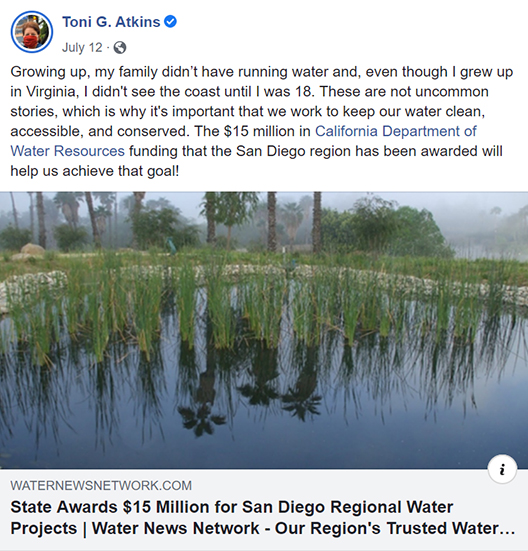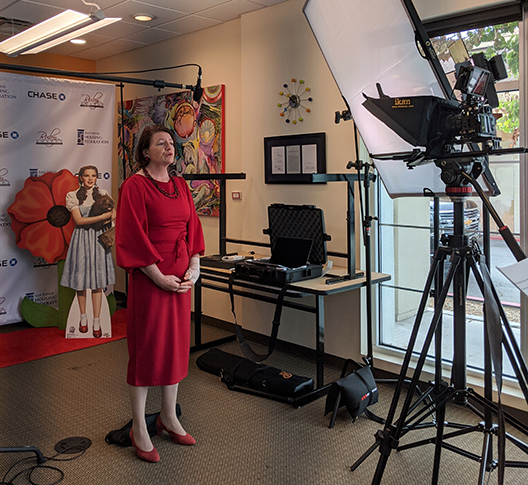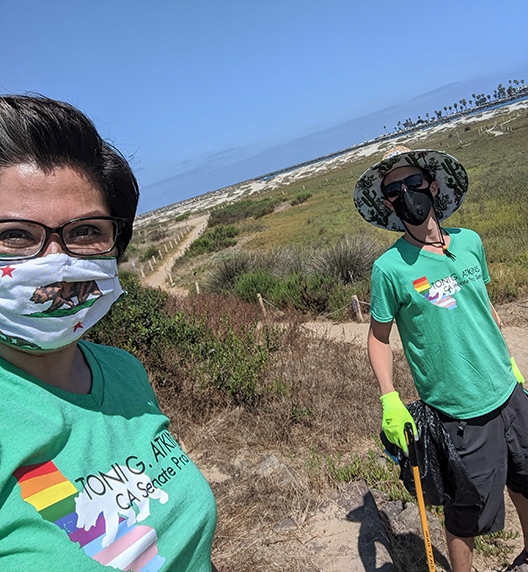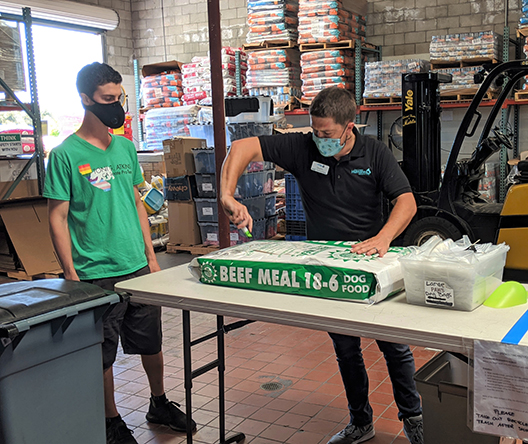August 2020 Newsletter
 |
For many California families, back to school season is typically marked by trips to the store to gather up binders, glue sticks, and other essentials for the coming academic year.
This year, instead of filling new backpacks with supplies to stuff in classroom desks, families are gathering the essentials their students need to start the school year from home. Software and scissors. Monitors and masks.
And for so many parents, the questions flow in a constant stream, melting into one constant concern – how do I best help my student prepare for and successfully complete another round of distance learning?
Governor Gavin Newsom announced in mid-July that all California schools in counties on the COVID-19 County Monitoring List need to continue distance learning in the fall until their county has been off the list for 14 days. While I support the need to safeguard students and families from the threat of the virus, I empathize with parents and guardians in San Diego and across the state who are grappling with preparing their students for more online instruction, while also continuing to work and support their families.
For advice, I turned to Dr. Shulamit Ritblatt, a professor of Child and Family Development at San Diego State University in the College of Education.
While we need to be creative about how we can offer in-person instruction so that students can return to campus and harness the social, emotional, and mental health benefits schools provide, Dr. Ritblatt said, there are things parents and guardians can do to help students prepare for distance learning.
When talking to your child about continued distance learning, be honest, and acknowledge and validate feelings of disappointment they may have. Include age-appropriate conversation about closing schools to stop the spread of COVID-19 and let your child express how they envisioned the school year, along with any potential obstacles and how to overcome them.
Work together to create a comfortable, inviting learning space, which can help provide students with a sense of control, predictability, and security. Make sure their daily routine includes break times, healthy snacks, exercise, rest, and play, and encourage them to use creative ways, like drawing or journaling, to communicate emotions. It’s also important that students connect with friends, even if it is only virtual, Ritblatt said.
When it comes to helping children and teens manage the emotional strain of not being on campus with peers and friends, there are warning signs to watch for, she said. Be on the lookout for mood and behavioral changes, including withdrawal, refusing to talk to friends or join online learning sessions, unexplained crying, thumb sucking, and increased conflict. If you spot unusual behavior, talk to your child about their feelings and what they’re experiencing. Your child’s pediatrician and teacher also are great resources and can work with you on ways to help your student.
The COVID-19 crisis has created huge challenges for our state and nation, and has taken a particularly tough toll on California families. Your resilience and dedication to helping mitigate the spread of this virus is admirable, and so very appreciated.
 |
I am happy to share that our region and Senate District 39 have been awarded more than $60 million in state grants within the past month. These key funds will help environmental, housing and equity projects move forward.
A total of $15 million in California Department of Water Resources grant funds are coming to our region to help fund several water recycling and conservation projects in the county.
This news hits close to home for me. Growing up, my family didn't have running water, which is why I've never taken water access for granted. These funds will support a variety of projects in our region, including nearly $1.5 million for the North City Pure Water Facility off of La Jolla Village Drive. The City of San Diego's goal is to provide one-third of the city’s water supply through recycled Pure Water by 2035. This project is just one part of reaching that goal. Another $1.4 million will help bolster water efficiency and conservation programs which will help to ensure that all residents and businesses have reliable, long-term water supply.
Since 2008, the San Diego region has secured more than $111 million in funds for 74 high-priority water projects.
 |
Affordable housing is another key priority of mine, because there truly is no place like home. I am pleased to share that St. Vincent de Paul’s high-rise housing project at 13th and Broadway in downtown San Diego received $46 million in state grants from the California Department of Housing and Community Development. Still in its planning phases, construction on the 273-unit project is scheduled to begin in 2021.
San Diego neighborhoods have also been allocated $738,000 through the California Department of Parks and Recreation, under the Proposition 68 Per Capita Grant Program passed by voters in 2018. This non-competitive grant program provides funding to support the rehabilitation, creation and improvement of local parks and to address deficiencies in neighborhoods lacking access to outdoor recreation facilities.
Grants are an important financing tool, and it just got easier to identify them! The California State Library has built and launched a new California Grants Portal for business owners, non-profits, tribal representatives, public agencies and individuals to find state grant and loan opportunities. Currently, there are more than 100 grants available valued at $18 billion (at the time of this publication). Visit Grants.CA.Gov for more information.
 |
Given the lower-than-average precipitation and snowpack this winter, 2020 is likely to be an active fire year. As wildfire season ramps up, California is using new tools, like the state’s recently acquired Black Hawk helicopters, to limit fire damage and is implementing new policies to lower the chances of COVID-19 transmission during wildfire emergencies. Despite having an interrupted legislative session this year, the Legislature successfully crafted a budget that further enhances our state’s wildfire prevention and suppression efforts.
This year’s budget provides funding for 172 new firefighter positions, 858 more seasonal firefighters, and six California Conservation Corps crews. The budget also addresses utility reform and wildfire safety, allocating $50 million for local governments to respond to public safety power shutdowns and $29.6 million for utility wildfire and safety process reform. To enhance forecasting and wildfire monitoring capabilities, the budget provides $2 million to support the new Wildfire Forecast and Threat Intelligence Center, and $4.4 million to implement new, pioneering wildfire predicting and modeling technology. Furthermore, the budget provides for modified evacuation protocols that will allow evacuees to maintain physical distancing and limit chances for COVID-19 transmission. These important budget allocations will help save lives and get wildfires contained faster.
 |
Like other highly populated areas of the state, San Diego County saw a substantial increase in COVID-19 cases in late-June and July, resulting in its placement on the state’s County Monitoring List. The Governor has asked counties on this list to ratchet back on reopening to reduce the opportunities for community transmission. Most businesses remain open but are operating under modified health guidelines until case numbers and hospitalizations are low enough to safely resume our phased approach to reopening. During this time, it is more important than ever that we take personal responsibility for keeping our community safe; this includes wearing a face mask in all public settings, practicing physical distancing whenever possible and washing your hands often. Together we can slow the spread of coronavirus and safely reopen our economy.
 |
Early on in the COVID-19 pandemic, the Senate created a Working Group on Economic Recovery to offer ideas for California’s fiscal rebound without raising taxes, while also focusing on the needs of all Californians, millions of whom have been adversely impacted by this crisis. I am pleased this has grown into a collaborative, bicameral effort with the Assembly.
The group, led by Senators Bob Hertzberg (D-Van Nuys) and Steven Bradford (D-Gardena), and Assemblymembers Phil Ting (D-San Francisco) and Jacqui Irwin (D-Thousand Oaks), aims to protect Californians and spur job creation during and even after the COVID-19 crisis.
The stimulus plan would raise $100 billion through a new tax voucher program and the acceleration of other existing revenue streams. The money would be used to boost the economy and protect jobs, small businesses, and working families.
The priorities would be divided amongst the following areas:
- New revenues without raising middle class taxes
- Support for small businesses
- Protections for working families, and
- Investing in our green economy
We will work together to approve measures by the August 31, 2020 legislative deadline and identify priorities for the next legislative session.
 |
The U.S. Constitution clearly states that every person who resides in the country must be accounted for in the Census, regardless of immigration status, native language, or zip code. Being counted is every person’s right. This count not only determines Congressional representation; it also determines how much actual money is allocated to our communities for critical services that we rely on every day. Funding for schools, public transit, hospitals, and much more is determined by Census data.
So far, 68% of San Diego County has responded, but those who haven’t will be visited at home by a Census worker. If you don’t want a knock on your door, fill out your Census today. You can submit it online or by calling 844-330-2020. We need everyone, in every neighborhood to participate to ensure we get the funding that we need and deserve.
|
Social Media Corner |
 |
 |
 |
 |
 |
 |
 |
 |
 |
|
|
|
|
|
|
|
|
|
|
|
|



